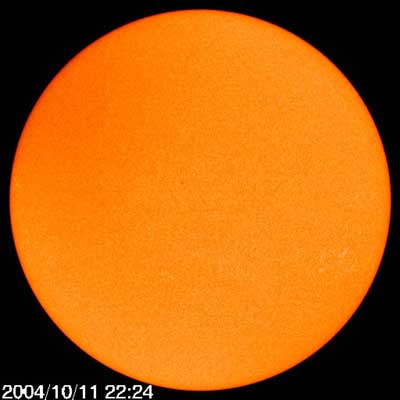Amit Oren

Direct link to this page: https://www.hayadan.org.il/sunspots241004.html
Six… long… years.
Solar physicist David Hathaway has examined the Sun every day since 1998, and every day there have been sunspots. Sunspots are "islands" about the size of a square meter on the surface of the sun. They are dark, relatively cold, strongly magnetized, and transient; A typical sunspot survives for several days or weeks before disintegrating. But when one stain breaks down, a new one replaces it.
Even at times of the lowest solar activity [low], you can find at least a spot or two on its surface. But when Tewi looked at the sun, on January 28, 2004 - there was not a single spot. The sun was completely empty.
Another similar incident happened for two whole days last week; Throughout the 11th and 12th of October, the sun was empty of any spot.
"This is a sign," says Hatvey, "that the solar minimum is coming, and it's coming earlier than we expected."
Minimum activity of the sun and maximum activity - in English: "Solar Min" and - "Solar Max", are two extreme situations in the activity of the sun that repeats itself once every 11 years. At maximum, the sun is full of spots, eruptions
Volcanics [Solar Flares], and throws huge amounts of clouds full of charged gas towards the east. This is a good time for observers enjoying the auroras [an atmospheric celestial phenomenon created by solar particles hitting the ESA's magnetic field], but definitely very dangerous for astronauts, who can be harmed by radiation storms. Other events and effects during that time include power outages, satellite crashes, GPS [Global Positioning System] systems malfunctioning, etc.
During the minimum period the phenomena are different; This is a period when the sun is calmer, and the number of spots on the sun is smaller, so much so that sometimes days and weeks pass without a single spot on the sun. The amount of volcanic eruptions on the Sun is low, and this is a safer time to fly in space, but a less interesting time to watch the polar sky.
Hetway is an expert in predicting the topic of the heat cycle. He follows the sunspots and their number (the best indicator of solar activity) and uses to predict years ahead, but this is not easy:
"Contrary to popular belief," says Hetwey, "the heat cycle is not exactly 11 years.", the length of this cycle, measured from minimum to minimum, varies: "The shortest cycles are nine years long, and the longest about 14." , and what makes a cycle long or short? Researchers aren't sure. "We don't even know if the current cycle is long or short - until it's over," says Hatvey.
But researchers are making progress. Hatvey and his colleague Bob Wilson [Wilson], who work at NASA's Space Flight Center
Marshall [Marshall] is believed to have found a simple way to predict the timing and date of the next minimum period.
"We examined data from the last eight heat cycles and discovered that minimum periods come after the spotless days, after
About 34 months after the maximum period," explains Hatvey.
The last known maximum was at the end of 2000. The first spot-free day was on January 28, 2004. And using the basic law established by Hewey and Wilson, the next minimum should arrive at the end of 2006 – a year earlier than previously thought.
On the other hand, believe that the next maximum may arrive earlier than expected. "Solar activity rapidly intensifies after minimum periods. In recent warm cycles, maximum periods followed minimum periods after a period of only about four years." says the twee. And if we do the calculation: 2006 + 4 = 2010. [Regarding the previous paragraph, in which it was mentioned that according to the calculation of the Twey-Wilson formula, the next minimum will arrive in 2006].
Until then, according to NASA's new space programs, robotic spacecraft will fly to the moon in preparation for humans to retrace it. If Hetway and Wilson's predictions are correct, these robots will need good shields; Volcanic eruptions on the sun and radiation storms can damage the "silicon brains" [chips] and the other electronic systems inside these robots.

Artisan concept for a future lunar exploration robot.
"For now," says Hatvey, "we are about to experience the 'calm before the storm.'" - and although he is an ardent fan of solar activity - he is waiting for a lull. "This will give us an opportunity to see if our 'clean-sun' method for predicting minimum periods followed by maximum periods, really works."
The next maximum - soon.
The article was first taken from the website: Science@NASA Story
מקור
The Israeli Astronomical Society
For information on the NASA website
The solar knower
https://www.hayadan.org.il/BuildaGate4/general2/data_card.php?Cat=~~~982543367~~~12&SiteName=hayadan

One response